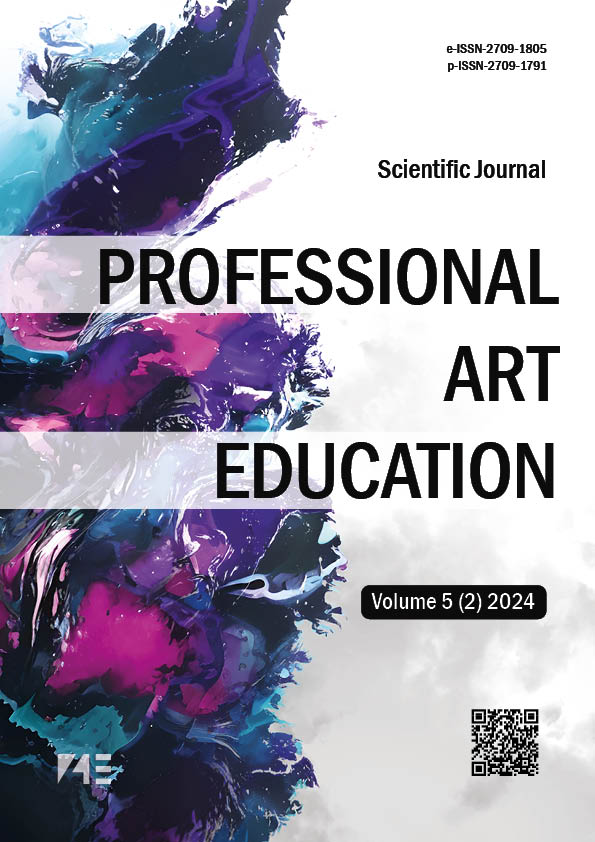Features of the implementation of the phenomenon "musicity" in dance tango
DOI:
https://doi.org/10.34142/27091805.2024.5.02.05Keywords:
Tango genre, tango dance, tango music, tango poetry, Argentine tango, Ballroom tango, musicality, choreographic art, methods, choreographyAbstract
The article provides a holistic analysis of the features of the implementation of the phenomenon of «musicality» in choreographic art, in particular in Tango dance.
Methods & methodology. The article used the principles of ambiguity, systematicity, historicism; methods of embodying musicality in dance through forms of perception, creation, performance (interpretation) and improvisation.
The scientific novelty of the article is to determine the content of the methods of musicality in Tango dance, as a reflection of psychological, performing, expert and artistic aspects; to reveal the etymology of the word «tango»; to determine the stages of formation and development of Tango dance; to distinguish specific types (Creole, Argentine, Ballroom and Finnish) of tango; to substantiate the forms - stage, sports and social.
Results. As a result of scientific research, it was found that Tango is a whole system of concepts, images, words and practices. It is impossible to understand a part of the whole if it is isolated from other parts of it. In the context of Tango, dance acquires meaning together with music, bandoneon – with the evoked nostalgia, memories from the past together with a certain way of visualizing the world, which is characteristic of true love for Tango. It is determined that Tango dance represents a musical and choreographic genre that integrated Afro-Argentine candombe and Andalusian tango, Argentine milonga, European polka and waltz, Spanish contradanza and Cuban habanera, the key feature of which is unpredictability. It is a progressive pair dance of a man and a woman, performed in a closed (contact or close) position, based on the principles of partner interaction, contrast and improvisation.
Conclusions. Analysis of the multifaceted nature and multi-valued connotations of the phenomenon of «musicality» in choreographic art allows us to identify various methods of its embodiment in Tango dance, such as methods of developing and educating dancers’ musical abilities, methods of expert assessment of performing skills, and methods of artistic embodiment of musicality in dance forms.
Downloads
References
Bhabha, H. (1996). «The Other Question.» In Contemporary Postcolonial Theory: A Reader, edited by P. Mongia. London: Arnold https://doi.org/10.4324/9781003135593
Castro, D.S. (1990). The Argentine Tango as Social History, 1880-1955: The Soul of the People. San Francisco, Calif.: Mellen Research University Press
Collier, S. (1995). «The Tango is Born: 1880s – 1920s.» In !Tango! The Dance, the Song, the Story, edited by Simon Collier, 18–64. London: Thames and Hudson Ltd.
Novati, J. & Cuello, I. (1980) Aspectos Histоrico-Musicales. In Antologia del Tango Rioplatense Vol. 1 (From its beginnings until 1920). Buenos Aires: Instituto Nacional de Musicologia «Carlos Vega»
Thompson, R. (2005). Tango: The Art History of Love. New York: Pantheon Books
Бугаєць, Н. А., Пінчук, О. І., & Мукін, В. С. (2024). Стаккато проти легато: феномен музикальності в європейських танцях. Наукові записки. Серія: Педагогічні науки, (215), 26–32. https://doi.org/10.36550/2415-7988-2024-1-215-26-32
Вакуленко, О. (2019). Специфіка хореографічних постановок «A Puro Tango Company». Альманах «Культура і Сучасність», (2). 86–90. http://nbuv.gov.ua/UJRN/Kis_2019_2_18
Віхров, К. (2017). Формування динамічного стереотипу техніки володіння м’ячом у тренуванні футболістів. Молодий вчений, 12 (52), 95–99. https://molodyivchenyi.ua/index.php/journal/article/view/5527
Ключко, В.В. (2015). Філософські засади ритміки Еміля Жак-Далькроза. Педагогічні науки: теорія, історія, інноваційні технології. 9 (53), 247–254. http://nbuv.gov.ua/UJRN/pednauk_2015_9_33
Максименко, С.Д. (2017). Теорія вищої нервової діяльності І. П. Павлова. Збірник наукових праць «Проблеми сучасної психології», (38). https://doi.org/10.32626/2227-6246.2017-38
Мозгальова, Н.Г. (2015). Музичні здібності, їх сутність і розвиток в процесі інструментально-виконавської підготовки вчителів музики. Педагогіка вищої та середньої школи : збірник наукових праць. (41). 98–104. https://doi.org/10.31812/educdim.v44i0.2658
Павлюк, Т. (2022). Бальна хореографія у країнах Південної Америки кінця ХVII – початку ХХІ століття. Українська культура : минуле, сучасне, шляхи розвитку. (40). 7–15. https://doi.org/10.35619/ucpmk.vi40.517
Федорченко, Д. Класифiкацiя сучасних стилiв танго. Актуальнi питання гуманiтарних наук. Вип. 28, том 5, 2020. С.220–224. https://doi.org/10.24919/2308-4863.5/28.208922
Черепанин, М. & Булда, М. (2023). Становлення жанру танго в контексті творчості Астора П’яцолли. Українська культура : минуле, сучасне, шляхи розвитку напрям мистецтвознавство / Теоретико-мистецькі аспекти української культури. (44). 52–57. https://doi.org/10.35619/ucpm.vi44.601
Downloads
Published
License
Copyright (c) 2024 Катерина Жерьобкіна, Борис Фоменко, Владислав Мукін (Автор)

This work is licensed under a Creative Commons Attribution-NonCommercial 4.0 International License.














